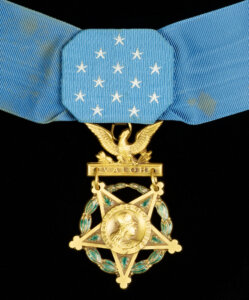The first traveling exhibit of the National Museum of the United States Army captures challenges faced by Americans of Japanese ancestry during World War II.
The exhibit theme – “I Am An American” – stems from a photograph taken by Dorothea Lange. The day after the attack on Pearl Harbor in 1941, the sign appeared on an Oakland, California, storefront owned by Tatsuro Matsudo.
Shortly thereafter, President Franklin D. Roosevelt issued Executive Order 9066 on February 19, 1942. It required the forced relocation and internment of nearly 120,000 Japanese Americans, most of whom were native-born American citizens.
The exhibit received its official public introduction in a mid-September joint press conference with congressional leaders on Capitol Hill. Attendees at the media announcement included U.S. Representatives Jill Tokuda and Mark Takano, White House Senior Advisor for Public Engagement Kota Mizutani, and the 34th Chief of Staff of the United States Army, retired Gen. Eric K. Shinseki.
World War II American soldiers of Japanese ancestry, known at Nisei soldiers, enlisted from the islands of Hawaii as well as the 10 Wartime Relocation Authority Camps. It is estimated that 19,000 Nisei served in the European Theater as part of the 100th Infantry Battalion, 442nd Regimental Combat Team, which went on to become the most decorated unit in U.S. military history for its size and duration of service. Also, another 6,000 Japanese-Americans served as translators and interpreters in the U.S. Army’s Military Intelligence Service.
Historical expertise
Providing historical expertise in developing the exhibit’s content is the National Veterans Network. According to the Christine Sato-Yamazaki, NVN executive director, “The exhibit highlights the patriotism, courage, and selfless service of the Japanese American Nisei soldiers who served courageously in the European and Pacific Theaters, while their families battled discrimination at home. Exploring five thematic areas, the 1,500-square-foot exhibit presents the national perspective of the Japanese American WWII soldier experience that includes the historical context of life in Hawaii and Wartime Relocation Authority camps.”
The challenge that Japanese-American soldiers faced was the two-front war. This temporary exhibit highlights their struggles, both at home and abroad, their courageous acts on the battlefield, and their long-awaited recognition culminating in the Congressional Gold Medal.
The museum is home to an unprecedented collection of Japanese American artifacts that capture the rarely told story of the Japanese American Nisei soldier during World War II.

One of those artifacts on display is a Medal of Honor. Pfc. Kaoru Moto was assigned to the all-Nisei 100th Infantry Battalion. On July 7, 1944, near Castellina Marittima, Italy, he single-handedly silenced two enemy machine gun positions while acting as a scout, and then destroyed a third despite being seriously wounded. For his actions, he was awarded the Distinguished Service Cross, which was upgraded to the Medal of Honor in 2000.
According to museum director Tammy Call, the exhibit will travel to 11 cities over its five-year tour. It will highlight 25-35 wartime objects to represent the service of the United States Army’s 100th Infantry Battalion, 442nd Regimental Combat team, and Military Intelligence Service. The first stop will be at the Presidio MIS Historic Learning Center in San Francisco in February 2026 before moving to the Bishop Museum in Honolulu, Oregon Historical Society in Portland, and Japanese American National Museum in Los Angeles. Additional venues will be announced at a later date.
The Army Historical Foundation is also supporting the production of the travelling exhibit. The special gallery on the Nisei experience will be displayed at the National Museum of the United States Army at Fort Belvoir, Virginia, until 2025.
Family life at War Relocation Centers
The “I Am An American” traveling exhibit dutifully captures the challenges of Japanese-American soldiers during World War II. But to get a glimpse of family life during those trying times, a visit to any of the 10 War Relocation Centers is a must.
Presented like a living museum, and overseen and operated by the National Park Service, each tells the story of living conditions at these remote facilities. For example, Heart Mountain Relocation Center in Park County, Wyoming, was built on 46,000 acres of dusty land owned by the Bureau of Reclamation. Incarcerees lived in a fenced area of camp that covered 740 acres. It was ringed with barbed wire and guarded by nine guard towers. There were 650 buildings and structures, including some 450 barracks. Incarcerees grew crops on 1,100 acres of farmland on the southeastern corner of the property.
During the 1,187 days the camp was open, the peak capacity reached 10,767, while 148 people died, and 556 babies were welcomed into the world.





















